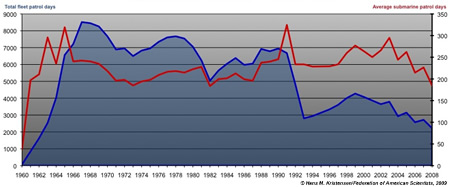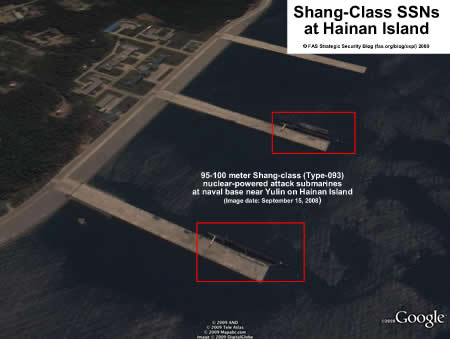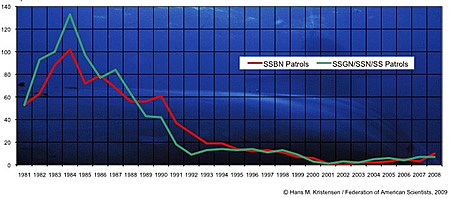Study Calls for New U.S. Nuclear Weapons Targeting Policy
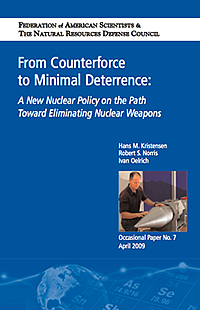 |
| Click on image for PDF-version of full report. |
By Hans M. Kristensen
The Federation of American Scientists and Natural Resources Defense Council today published a study that calls for fundamental changes in the way the United States military plans for using nuclear weapons.
The study From Counterforce to Minimal Deterrence: A New Nuclear Policy on the Path Toward Eliminating Nuclear Weapons recommends abandoning the decades-old “counterforce” doctrine and replacing it with a new and much less ambitious targeting policy the authors call Minimal Deterrence. [Update: see Washington Post – Report Urges Updating of Nuclear Weapons Policy]
Global Security Newswire reported last week that Department of Defense officials have concluded that significant reductions to the nuclear arsenal cannot be made unless President Barack Obama scales back the nation’s strategic war plan. The FAS/NRDC report presents a plan for how to do that.
The last time outdated nuclear guidance stood in the way of nuclear cuts was in 1997, when then President Clinton had to change President Reagan’s 17-year old guidance to enable U.S. Strategic Command (STRATCOM) to go to the START-III force level that the Bush administration subsequently adopted as the Moscow Treaty force level. The series of STRATCOM force structure studies examining lower force levels is described in The Matrix of Deterrence.
Resources: Full Report | US Nuclear Forces 2009 | United States Reaches Moscow Treaty Warhead Limit Early | Press Conference Video
From Counterforce to Minimal Deterrence: A New Nuclear Policy on the Path Toward Eliminating Nuclear Weapons
Though the nuclear arsenal of the United States is smaller than it was during the Cold War, the day-to-day deployment of forces has changed very little. The United States still has weapons ready to launch at a moment’s notice at all times.
The reason is simple: the mission for nuclear weapons has not changed from the time of the Cold War.
Most Americans would be surprised to discover that the instructions to our nuclear targeteers still include a requirement for a surprise first strike against Russian nuclear forces to destroy them on the ground. It is time to shift the focus from reducing numbers of nuclear weapons to reducing the missions of nuclear weapons.
New Pentagon Report on Chinese Military Forces
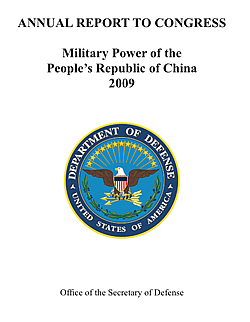 |
| The 2009 Pentagon report shows hardly any changes of Chinese nuclear forces. |
By Hans M. Kristensen
The new annual report on Chinese military forces published by the Pentagon shows essentially no changes in China’s nuclear forces compared with the previous report from 2008.
Perhaps most interestingly, the report shows that China has not increased the number of new DF-31 and DF-31A ballistic missiles, a deployment that has to pick up if the recent Defense Intelligence Agency projection that China’s “number of ICBM warheads capable of reaching the United States could more than double in the next 15 years” is to come true.
Russian Tactical Nuclear Weapons
 |
| New low-yield nuclear warheads for cruise missiles on Russia’s submarines?. |
.
By Hans M. Kristensen
Two recent news reports have drawn the attention to Russia’s tactical nuclear weapons. Earlier this week, RIA Novosti quoted Vice Admiral Oleg Burtsev, deputy head of the Russian Navy General Staff, saying that the role of tactical nuclear weapons on submarines “will play a key role in the future,” that their range and precision are gradually increasing, and that Russia “can install low-yield warheads on existing cruise missiles” with high-yield warheads.
This morning an editorial in the New York Times advocated withdrawing the “200 to 300” U.S. tactical nuclear bombs deployed in Europe “to make it much easier to challenge Russia to reduce its stockpile of at least 3,000 short-range weapons.”
Both reports compel – each in their own way – the Obama administration to address the issue of tactical nuclear weapons.
The Russian Inventory
Like the United States, Russia doesn’t say much about the status of its tactical nuclear weapons. The little we have to go by is based on what the Soviet Union used to have and how much Russian officials have said they have cut since then.
Unofficial estimates set the Soviet inventory of tactical nuclear weapons at roughly 15,000 in mid-1991. In response to unilateral cuts announced by the United States in late 1991 and early 1992, Russian President Boris Yeltsin pledged in 1992 that production of warheads for ground-launched tactical missiles, artillery shells, and mines had stopped and that all such warheads would be eliminated. He also pledged that Russia would dispose of half of all airborne and surface-to-air warheads, as well as one-third of all naval warheads.
In 2004, the Russian Foreign Ministry stated that “more than 50 percent” of these warhead types have been “liquidated.” And in September 2007, Defense Ministry official Colonel-General Vladimir Verkhovtsev gave a status report of these reductions that appeared to go beyond President Yeltsin’s pledge.
Based on this, Robert Norris and I make the following cautious estimate (to be published in the Bulletin of the Atomic Scientists in late April) of the current Russian inventory of tactical nuclear weapons:
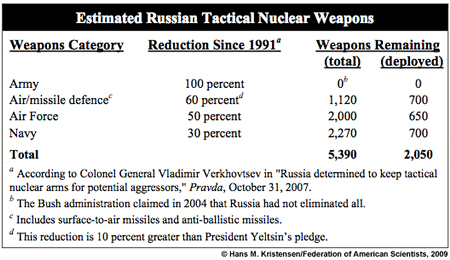 |
| Estimate from forthcoming Nuclear Notebook in the Bulletin of the Atomic Scientists. |
.
Based on the number of available nuclear-capable delivery platforms, we estimate that nearly two-thirds of these warheads are in reserve or awaiting dismantlement. The remaining approximately 2,080 warheads are operational for delivery by anti-ballistic missiles, air-defence missiles, tactical aircraft, and naval cruise missiles, depth bombs, and torpedoes. The Navy’s tactical nuclear weapons are not deployed at sea under normal circumstances but stored on land.
The Other Nuclear Powers
The United States retains a small inventory of perhaps 500 active tactical nuclear weapons. This includes an estimated 400 bombs (including 200 in Europe) and 100 Tomahawk cruise missiles (all on land). Others, perhaps 700, are in inactive storage.
France also has 60 tactical-range cruise missiles, including some on its aircraft carrier, although it calls them strategic weapons.
The United Kingdom has completely eliminated its tactical nuclear weapons, although it said until a couple of years ago that some of its strategic Trident missiles had a “sub-strategic” mission.
Information about possible Chinese tactical nuclear weapons is vague and contradictory, but might include some gravity bombs.
India, Pakistan, and Israel have some nuclear weapons that could be considered tactical (gravity bombs for fighter-bombers and, in the case of India and Pakistan, short-range ballistic missiles), but all are normally considered strategic.
| Russian Nuclear-Capable Cruise Missile Launch |
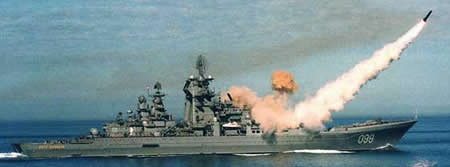 |
| A nuclear-capable SS-N-19 Shipwreck cruise missile is launched from a Kirov-class nuclear-powered guided missile cruiser. The ship is equipped with 20 launchers for the SS-N-19 missile, which can carry a 500-kiloton warhead. Other tactical nuclear weapon systems include the SS-N-16 anti-submarine rocket, and the SA-N-6 anti-air missile. |
.
Implications and Issues
Whether Vice Admiral Burtsev’s statement is more than boasting remains to be seen, but it is a timely reminder to the Obama administration of the need to develop a plan for how to tackle the tactical nuclear weapons.
Russia’s nuclear posture is now approaching a situation where there are more tactical nuclear weapons in the inventory than strategic weapons. And NATO’s remnant of the Cold War tactical nuclear posture in Europe seems stuck in the mud of nuclear dogma and bureaucratic inaction.
None of these tactical nuclear weapons are limited or monitored by any arms control agreements, and – for all the worries about terrorists stealing nuclear weapons – are the most easy to run away with.
In April, NATO is widely expected to kick off a (long-overdue) review of its Strategic Concept from 1999. It would be a mistake to leave the initiative on what to do with the tactical nuclear weapons to the NATO bureaucrats. The vision must come from the top and President Obama needs to articulate what it is soon.
France’s Nuclear Victims (and Correct Number of Weapons)
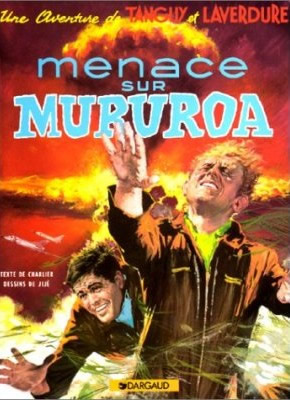 |
| From Tanguy et Laverdure, Menace sur Mururoa, 1996. |
By Hans M. Kristensen
The news media reports that the French government has decided to “pay compensation to those suffering illnesses linked to radiation” from the French nuclear tests conducted in Northern Africa and the South Pacific between 1960 and 1996. This being the same state that for decades denied any health effects from the tests.
Many of the news reports quote FAS estimating the French nuclear arsenal at 348 warheads in 2008. For the record, our latest estimate made in July 2008 is about 300 warheads.
Additional Resources: French Nuclear Forces 2008 (Bulletin of the Atomic Scientists, July 2008) | Status of World Nuclear Forces (FAS web site)
U.S. Strategic Submarine Patrols Continue at Near Cold War Tempo
 |
| U.S. ballistic missile submarines conducted 31 nuclear deterrent patrols in 2008 at an operational tempo comparable to that of the Cold War. |
.
By Hans M. Kristensen [updated]
The U.S. fleet of 14 nuclear-powered ballistic missile submarines conducted 31 nuclear deterrent patrols in 2008 at an operational tempo comparable to during the Cold War.
The new patrol information, which was obtained from the U.S. Navy under the Freedom of Information Act, coincides with the completion on February 11, 2009, of the 1,000th deterrent patrol by an Ohio-class submarine since 1982.
The information shows that the United States conducts more nuclear deterrent patrols each year than Russia, France, United Kingdom and China combined.
Patrols by the Number
The 31 patrols conducted in 2008 top a 48-year history of continuous deterrent patrols. Since the USS George Washington (SSBN-598) departed Charleston, S.C., on the first nuclear-powered ballistic missile submarine (SSBN) patrol on November 15, 1960, 59 SSBNs have conducted 3,814 patrols through 2008 (see Figure 1).
.
The annual number of patrols has fluctuated considerably over the years, peaking at 131 patrols in 1967. Declines occurred mainly due to retirement of SSBNs rather than changes in the mission. The retirement of the early classes of SSBNs in 1979-1981 almost eliminated patrols in the Pacific, but the new Ohio-class gradually rebuilt the posture. The stand-down of Poseidon SSBNs in October 1991 and the retirement of all non-Ohio-class SSBNs by 1993 reduced Atlantic patrols by nearly 60 percent. The patrols increased again in the second half of the 1990s and more Ohio-class SSBNs were added to the fleet, but started dropping from 2000 as four Ohio-class SSBNs were withdrawn from nuclear missions and four others underwent lengthy backfits from the Trident I C4 to the Trident II D5 Trident missile.
|
Figure 2: |
 |
|
The United States conducts more SSBN patrols than all other nuclear powers combined. China’s SSBNs have yet to conduct a deterrent patrol. |
During the Cold War standoff with the Soviet Union, the vast majority of patrols were done in the Atlantic Ocean. Since the early 1990s, patrols in the Atlantic have plummeted and the SSBN force been concentrated on the west coast. The majority of U.S. SSBN patrols today occur in the Pacific.
The current number of patrols is significantly greater than the patrol levels of other countries with sea-based nuclear weapon systems. In fact, the U.S. navy conducted three times the number of SSBN patrols that the Russian navy did in 2008, and more patrols than Russia, France, Britain and China combined (see figure 2).
High Operational Tempo
Although the total annual number of SSBN patrols has decreased significantly since the end of the Cold War, the operational tempo of each submarine has not. Each Ohio-class SSBNs today conducts about the same number of patrols per year as during the Cold War, but the duration of each patrol has increased, with each submarine spending approximately 50-60 percent of its time on patrol (see Figure 3).
.
The high operational tempo is made possibly by each SSBN having two crews, Blue and Gold. Each time a submarine returns from a patrol, the other crew takes over, spends a few weeks repairing and replenishing the boat, and takes the SSBN out for its next patrol.
The data also reveals a couple of interesting spikes of increased patrols in 1963/1965 and 1991. The reasons for this increased activity is not known but the periods coincide with the Cuban missile crisis and the failed coup attempt in the final days of the Soviet Union in 1991.
Another way to examine the data is to see how may patrol days each submarine and the fleet accumulate each year. During the Cold War the larger submarine fleet averaged approximately 6,000 patrol days each year, with a peak of 8,515 patrol days in 1967. That performance declined to an average of 3,400 days in the post-Cold War era as the size of the SSBN fleet was reduced. With the removal of four SSBNs from nuclear operations and four others undergoing lengthy missile backfits, the fleet’s total patrol days has now dropped to a little over 2,200 (see figure 4).
.
Yet total patrol day numbers can be deceiving because they can obscure how each submarine is doing. Because the Ohio-class SSBN design was optimized for lengthy deterrent patrols, the average number of days each submarine spends on patrol has been higher in the post-Cold War period than during the Cold War itself. Patrols can be shortened by technical problems, but many Ohio-class submarines today stay on patrol for more than 80 days. Last year, the USS Maine (SSBN-741) conducted a 98-day patrol in the Pacific.
What is a Deterrent Patrol?
An SSBN deterrent patrol is an extended operational deployment during part of which the submarine covers its assigned target package in support of the strategic war plan. Each Ohio-class patrol typically lasts 60-90 days, but one submarine in late 2008 conducted an extended patrol of 98 day and patrols have occasionally exceeded 100 days. Occasionally a patrol is cut short by technical problems, in which case another SSBN can be deployed on short notice. As a result, patrols today in average last about 72 days.
Being on patrol does not mean the submarine is continuously submerged on-station and holding targets at risk. In fact, when the submarine is not on Hard Alert holding targets at risk in Russia, China, or regional states, much of the patrol time is spent on cruising between homeport, patrol areas, exercising with other naval forces, undergoing inspections and certifications, performing Weapon System Readiness Tests (WSRTs), conducting retargeting exercises, and Command and Control exercises.
Another activity involves so-called SCOOP exercises (SSBN Continuity of Operations Program) where the SSBN will practice replenishment or refit in forward ports in case the homeport is annihilated in wartime. In the Pacific, the SCOOP ports include Pearl Harbor, Hawaii (see Figure 5), Guam, Seaward, Alaska, Astoria, Oregon, and San Diego, California. In the Atlantic they include Port Canaveral and Mayport, Florida, Roosevelt Roads, Puerto Rico, and Halifax, Canada. The SSBN may even return to its homeport and redeploy a day or two later on the same patrol.
|
Figure 5: |
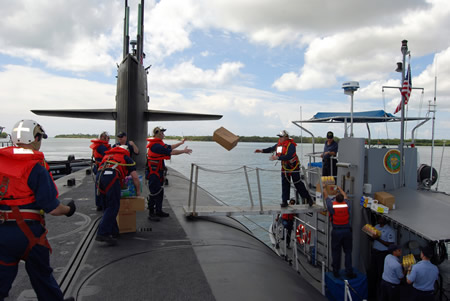 |
| USS Henry M. Jackson (SSBN-730) loading fresh fruit in Pearl Harbor during a SCOOP visit to Hawaii in March 2008 on its first patrol after a four-year overhaul where it was refueled and modernized to carry the Trident II D5 ballistic missile. |
.
Although patrols normally end at the base where they started, this is not always the case. An SSBN that departs Naval Submarine Base Bangor, Washington, might go on-station for several weeks in alert operational areas, conduct various training and exercises, and then arrive at Pearl Harbor in Hawaii. After a brief port visit and replenishment the submarine typically resumes its patrol and eventually returns to Bangor. But sometimes the patrol will end in Hawaii, a new crew be flown in to replace the old, and the submarine undergo refit at the forward location as part of a SCOOP exercise. The SSBN then departs Hawaii on a new patrol, goes on-station in alert operational areas, conducts more exercises and inspections, and eventually returns to Bangor where the new patrol ends.
This type of broken up patrol where the submarine is allowed to do more than on-station operations is sometimes described as “modified alert” and said to be different from the Cold War. But SSBNs have never been on-station all the time, with most deployed submarines being in transit between on-station alert areas and other non-alert operations. In fact, “modified alert” patrols date back to the early 1970s.
Of the 14 SSBNs currently in the fleet, two are normally in overhaul at any given time. Of the remaining operational 12 submarines, 8-9 are deployed on patrol at any given time. Four of these (two in each ocean) are on “Hard Alert” while the 4-5 non-alert SSBNs can be brought to alert level within a relatively short time if necessary. One to three SSBNs are in refit at the home base in preparation for their next patrol.
The SSBNs on Hard Alert continuously hold at risk facilities in Russia, China and regional states with an estimated 384 nuclear warheads on 96 Trident II D5 missiles that can be launched within “a few minutes” after receiving the launch order. The targets in the “target packages” are selected based on the taskings of the strategic war plan, known today as Operations Plan (OPLAN) 8010.
What is the Mission?
But why, nearly two decades after the Cold War ended, are 28 crews ordered to sail 14 SSBNs with more than 1,000 nuclear warheads on 30-plus patrols each year at an operational tempo comparable to that of the Cold War?
The official line is, as stated last month by Secretary of the Navy Donald Winter during the celebration of the 1,000th Ohio-class deterrent patrol, that “the ability of our Trident fleet to [be ready to launch its missiles] 24 hours a day, seven days a week, 365 days a year, has promoted the interests of peace and freedom around the world….Since the beginning of the nuclear age, the world has seen a drastic reduction in wartime deaths.”
|
Figure 6: |
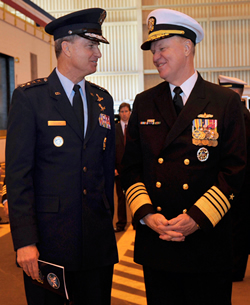 |
|
STRATCOM commander General Kevin Chilton (left) and Chief of Naval Operations Admiral Gary Roughead. General Chilton says SSBNs deter not only nuclear conflict but “conflict in general” and are “as equally important today, as they ever were during the height of the Cold War.” |
The warfighters add more nuances, including Commander Jeff Grimes of the Trident submarine USS Maryland (SSBN-738) who at the start of a recent deterrent patrol explained it to Navy Times: “There are nuclear weapons in the world today. Many nations have them. Proliferation is possible in the growing technologies societies have. The power of the deterrent is the knowledge that the capability exists in the hands of controlled people. So on a global scale, deterrence is showing how it’s working every day. We haven’t had a global, world war, in a long time,” he said. “Intelligence is different, the threats are different, so we do adjust the planning and contingencies for strategic operations continually to face the threats that may or may not be seen….We’re there on the front line, ready to go,” Grimes declared.
STRATCOM commander General Kevin Chilton, who in a war would advise the president on which nuclear strike options to use, said recently that although some people thought the Trident mission would end with the 1991 collapse of the Soviet Union, the SSBNs “are as equally important today, as they ever were during the height of the Cold War….The application of deterrence can actually be more complicated in the 21st century, but some fundamentals don’t change,” he said and added: “And it is not just to deter nuclear conflict. These forces have served to deter conflict in general, writ large, since they’ve been fielded.”
These are strong and diverse claims that are also made in some of the command histories that each SSBN produces. Some of them state that the mission is to “maintain world peace,” which has certainly not been the case in the post-Cold War era. Others describe the mission as “providing strategic deterrence to prevent nuclear war” (my emphasis), which sounds more credible. But even in that case, can we really tell whether it is the SSBNs that prevent nuclear war and not the ICBMs or bombers?
The enormous differences between maintaining world peace, preventing wars, and preventing nuclear war demand that officials articulate the SSBN mission much more clearly. To that end, it would be good to hear why it takes 12 operational SSBNs with more than 1,100 nuclear warheads on 30-plus patrols per year to deter nuclear attack against the United States, but only three operational SSBNs with less than 160 warheads on six patrols per year to safeguard the United Kingdom.
|
Figure 7: |
 |
| USS Maryland (SSBN-738) departs Kings Bay on February 15, 2009, for its 53rd deterrent patrol in the Atlantic Ocean to prevent nuclear war, prevent world war, deter conflict, maintain world peace, promote the interests of peace of freedom, deter proliferators, in a mission that remains“equally important…as during the height of the Cold War,” depending on who is describing it. |
.
Last year Russia’s SSBNs returned to sea at a level not seen in a decade and it plans to build eight new Borey-class SSBNs with new multi-warhead missiles. France is completing its fourth Triomphant-class SSBNs also with a new multi-warhead missile, and Britain has announced plans to build four new SSBNs. China is building 3-5 new Jin-class SSBNs with 8000-kilometer missiles, and India is said to be working on an SSBN as well. The U.S. Navy has also begun design work on its next ballistic missile submarine to replace the Ohio-class.
In short, the nuclear powers seem to be recommitting themselves to an era of deploying large numbers of nuclear weapons in the oceans. Most people tend to view sea-based nuclear weapons as the most legitimate leg of the Triad. Yet of all strategic nuclear weapons, sea-based ballistic missiles are the most difficult to track, the most problematic to communicate with in a crisis, the hardest to verify in an arms control agreement, and the only ones that can sneak up on an adversary in a surprise attack.
If the Obama administration wants to decisively move the world toward “dramatic reductions” and ultimately the elimination of nuclear weapons, then it must seek answers to these issues. In the short term, it needs to ask whether the Cold War operational tempo of U.S. SSBNs is counterproductive by sending a signal to other nuclear weapon states that triggers modernization of their forces and makes reductions harder to achieve than otherwise. In other words, what is the net impact of the SSBN patrols on U.S. national security objectives in an era of pursuing nuclear disarmament?
Addition Resources: Russian Sub Patrols | Chinese Sub Patrols
_____________________________________________________________
US-Chinese Anti-Submarine Cat and Mouse Game in South China Sea
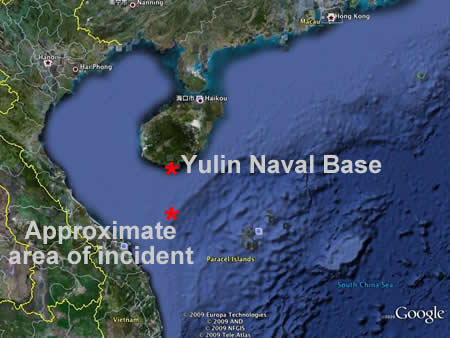 |
| The Chinese military harassment of a U.S. submarine surveillance vessel Sunday occurred only 75 miles from China’s growing naval base near Yulin on Hainan Island. |
.
By Hans M. Kristensen [updated 1:50 P.M., 3/10/09]
The incident that unfolded in the South China Sea Sunday, where the U.S. Navy says five Chinese ships harassed the U.S. submarine surveillance vessel USNS Impeccable, appears to be part of a wider and dangerous cat and mouse game between U.S. and Chinese submarines and their hunters.
News media reports cite Pentagon reports of half a dozen other incidents just within the past week in which U.S. surveillance vessels were “subjected to aggressive behavior, including dozens of fly-bys by Chinese Y-12 maritime surveillance aircraft.”
The latest incident allegedly occurred in international waters only 75 miles south of a budding naval base near Yulin on Hainan Island from where China has started operating new nuclear attack and ballistic missile submarines. The U.S. Navy on its part is busy collecting data on the submarines and seafloor to improve its ability to detect the submarines in peacetime and more efficiently hunt them in case of war.
|
USNS Impeccable (T-AGOS-23) |
 |
|
The USNS Impeccable was designed specifically as a platform for the SURTASS towed array and its Low Frequency Array upgrade. |
An Impeccable “Civilian Crew”
The U.S. Navy’s description of the incident states that “a civilian crew mans the ship, which operates under the auspices of the Military Sealift Command.” Yet as one of five ocean surveillance ships, the USNS Impeccable (T-AGOS 23) has the important military mission of using its array of both passive and active low frequency sonar arrays to detect and track submarines. The USNS Impeccable works directly with the Navy’s fleets, and in 2007 operated with the three-carrier strike battle group in Valiant Shield 07 exercise in the Western Pacific.
USNS Impeccable is equipped with the Surveillance Towed Array Sensor System (SURTASS), a passive linear underwater surveillance array attached to a tow cable. SURTASS was developed as a floating submarine detection system for deep waters, and the Navy wants to add an active Low Frequency Array (LFA) to improve long-range detection of submarines in shallow waters.
|
SURTASS LFA Deployment |
 |
| The SURTASS LFA passive-active surveillance system is designed to detect submarines and surface ships at long range in deep and shallow waters. |
.
Indeed, according to the U.S. Navy, the USNS Impeccable is “designed specifically as a platform for the SURTASS towed array and its LFA adjunct.”
New Chinese Nuclear Submarines at Yulin Naval Base
Among Chinese submarines the USNS Impeccable was monitoring is probably the Shang-class (Type-093) nuclear-powered attack submarine, a new class China is building to replace the old Han-class, and which has recently been seen at the Yulin base.
A commercial satellite image taken September 15, 2008, shows two Shang-class submarines present at the base, the first time – to my knowledge – that two Shang-class SSNs have been seen at the base at the same time.
.
An earlier image from February 2008 showed a Jin-class (Type-094) ballistic missile submarine at the Hainan base for the first time. The Jin-class is not visible on the later image. China has been reducing its submarine fleet by replacing old boats with fewer modern ones. The submarines normally stay close to shore, but in 2008 sailed on 12 longer patrols – twice as many as in 2007.
Time For an Incident Agreement
The incident begs the question who or at what level in the Chinese government the harassment in international waters was ordered. The incident will make life harder for those in the Obama administration who want to ease the military pressure on U.S.-Chinese relations, and easier for hardliners to argue their case.
For both countries the Sunday incident and the many other incidents that have occurred recently are reminders that the time is long overdue for an agreement to regulate military operations. Following a break in response to U.S. military sales to Taiwan, U.S.-Chinese mid-level military-to-military talks were scheduled to resume last month, and the Commander of U.S. Pacific Command, Admiral Timothy Keating, said “nascent initiatives” were underway to draw up some “rules of the road” to address some of these issues.
Absent a substantial agreement, building on the 1998 US-Chinese Military Maritime Safety Agreement (which already includes discussions on “interpretation of the Rules of the Nautical Road and avoidance of accidents-at-sea”) and the 1972 US-Russian Incidents at Sea Agreement, incidents like the USNS Impeccable incident will continue as a serious irritant and source of mistrust between China and the United States, a situation neither country nor other nations in the region can afford.
Additional resources: US-Chinese Military Maritime Safety Agreement (1998) | US-Russian Incidents at Sea Agreement (1972) | Secrecy News Blog: U.S., China, and Incidents at Sea
Iran’s Uranium: Don’t Panic Yet.
By Ivan Oelrich and Ivanka Barzashka
Last week, the New York Times and the Financial Times USA ran stories that implied that Iran had been hiding enriched uranium and had been caught red-handed during the most recent International Atomic Energy Agency (IAEA) physical inventory inspection. While supposedly based on the IAEA report (GOV/2009/8), the articles more closely followed the ISIS analysis of the report. [Jeffery Lewis, as usual, also has good analysis and comments on Arms Control Wonk.] The IAEA report itself raises few alarm bells. Yes, the Iranians are continuing to enrich uranium; yes, they claim it is exclusively for a civilian nuclear reactor program, a claim for which no one can provide credible assurances, and, yes, every day they enrich uranium, they are closer to having enough for nuclear weapon capability, once that political decision is made. But the IAEA report does not reveal any sudden jump in enrichment capability or even uranium inventory and it goes out of its way to say that the result of the inspection is consistent with what was previously declared by Iran, within “the measurement uncertainties normally associated with enrichment plants of similar throughput”. So what is the issue here?
The Financial Times headline, “Iran holds enough uranium for bomb” with the subtitles “UN report reveals leap in nuclear stocks” and “Capacity breaches Israel’s ‘red line’ limit,” and the New York Times headline, “Iran Has More Enriched Uranium than Thought” are both more provocative than warranted by the IAEA report itself. Both articles report that, in the most recent IAEA report from 19 February, the estimated inventory of low-enriched uranium (LEU) had jumped by a third. The New York Times said that the IAEA had “discovered” an additional 460 pounds (or 209 kg) of LEU. This number is wrong to begin with because the IAEA reported an additional 209 kg, not of uranium, but of uranium hexafluoride (UF6). UF6 is about 68 percent uranium, so there is only an additional 142 kg of uranium in 209 kg of UF6. We will come back to this.
Reasoning Behind the Headlines
“Discovered” is stretching. The origin of that 209 kg is the difference between the amount of enriched UF6 reported in IAEA documents GOV/2009/8 and GOV/2008/59 — two consecutive reports for Iran’s inventory as of November 2008. The IAEA report of 19 November 2008 states that from February 2007 to 7 November 2008 “…based on the operator’s daily accounting records, Iran had produced approximately 630 kg of low enriched UF6 [uranium hexafluoride]. All nuclear material at FEP [Fuel Enrichment Plant], as well as all installed cascades, remain under Agency containment and surveillance.”
The next IAEA report, released just last Thursday 19 February 2009, contained the results of the IAEA physical inventory verification (PIV) that took place between 24 and 26 November 2008. According to the PIV, Iran had produced 839 kg of low enriched UF6 from February 2007 to 17 November 2008.
The most important point is that these two “inventories” were very different animals. The 7 November inventory was based on adding up the entries in the operators’ logbooks and developing an estimate of overall LEU stockpile. For the PIV, the IAEA actually measured how much LEU the Iranians had on hand. Ideally, the two should match quite closely, so one would expect that the November LEU according to the two reports would be the same. If there is a discrepancy, then Iran may be hiding something.
Is there a discrepancy?
So if there is an extra 209 kg of UF6, why doesn’t the IAEA report scream fraud? Because according to the IAEA reports, all the quantities of UF6 produced balance out with the measured inputs so no uranium has gone missing and none that was hidden has suddenly appeared. All of the uranium and enrichment equipment was under constant IAEA monitoring so nothing was “discovered” except in a bookkeeping sense. The Iranians knew during the 7 November inspection that the IAEA measurement verification was coming a fortnight later. The Iranians are at least months away from getting significant quantities of highly enriched uranium (HEU), so it seems unlikely that they were trying to hide any LEU inventory for only a couple of weeks to get any head start on the IAEA inspectors.
The logbook inventory and the measurement inventory took place ten days apart. Could that account for more the difference? Most likely not. In the following measurement period, from 17 November 2008 to 31 January 2009 ( 75 days) the Iranians enriched an additional 171 kg of UF6 or 2.28 kg UF6/day. Similarly, from 30 August 2008 to 7 November 2008 Iran enriched an average of 2.17 kg UF6/day. So from November 7th to the 17th,we might expect them to enrich an additional 22 to 23 kg, or only about ten percent of the 209 kg difference we are concerned with. So the additional 10 days’ production cannot account for the difference.
Explanations.
It is more plausible that the Iranians, novices at the centrifuge business, have not developed sophisticated measurement and recording systems to track their own production. The IAEA reports do not contain enough detail to determine the source of the discrepancy but there are many possibilities. We do not know what containers the Iranians use to store their UF6 (the international standard is a steel cylinder called the 30B, which can hold up to 2.5 tons of UF6 and is too big for Iran’s program). UF6 is a solid at room temperature and pressure. It is stored by pumping the gas from the centrifuges into a cylinder, where the UF6 condenses into a white solid. Because the gas condenses on the inside, the gas pressure does not go up as more gas is pumped in. Knowing how much UF6 is in the tank is not as simple, therefore, as reading a pressure gauge –the mass of the cylinders must be measured. The storage containers can be weighed continually; that is, the cylinders essentially sit on a scale but perhaps the Iranians don’t do that. If cylinders are moved from the production area to a storage area only when full and are then weighed, jumps in measured inventory are expected.
The 17 November PIV was the second IAEA physical inventory since Iran began enrichment in February 2007. The first one was done in December 2007. The IAEA report (GOV/2008/4) announcing the results of the December 2007 PIV did not report any inconsistencies in inventory or Iran’s technical problems reporting LEU. The report was also the first time that enriched amounts of UF6 were disclosed and it commented that “the throughput of the facility had been well below its declared design capacity.” There are no prior published logbook enrichment amounts to compare the December PIV results to, probably because of the small cascade throughput. Consequently, we do not have evidence that Iran has ever understated production previously and obviously we have no comparison for historical logbook-to-inventory accuracy.
Not Enough for a Breakout…Yet.
By “breakout” they mean that, by starting with LEU, Iran could use its enrichment capacity to more quickly produce a bomb’s worth of the highly-enriched uranium needed for a bomb than it could if it were starting with natural uranium. While true in theory, the numbers presented by the IAEA indicate that Iran is not quite there.
Natural uranium has two isotopes (well, a trace of a third, but we can ignore that). In natural uranium, the U-238 is 99.3 percent and the U-235 is 0.7 percent. A reactor requires uranium that is 3-5 percent U-235 and a bomb requires uranium that is 90 or so percent U-235. By saying that the Iranians have enough LEU to further enrich to make a bomb, both articles are depending on simplistic calculations contained in the ISIS summary that look solely at the amount of U-235 in the LEU and see that it adds up to the 25 kg that is estimated to be required of a bomb. But just taking the quantity of LEU and multiplying by the U-235 concentration does not work because not all of the U-235 is recovered.
It is amazing how helpful even a little arithmetic can be. Taking the IAEA number, as of last November, the Iranians had fed 9956 kg of natural UF6 into their machines. Natural uranium is 0.71 percent U-235 so 9956 kg of UF6 contains 47.6 kg of U-235. During this time, the Iranians produced 839 kg of 3.5 percent LEU UF6. Multiply that out and we discover that the LEU contains 20.0 kg of U-235, which seems to imply there is not quite enough U-235 for a bomb, assumed to require 25 kg or so. (Note that if the calculations are redone using the masses, not of uranium, but of UF6, then the result is more than 29 kg, which would be enough for a bomb if it were pure uranium, not UF6. We suspect there is some confusion in the uranium-to-UF6 conversions.) But note that that also means that 27.8 kg of U-235 ended up in the waste or “tails,” which is to say that the Iranians are throwing away 58 percent of the U-235 that goes into the their machines. If the Iranians just recycled their LEU through the existing centrifuges, they would still throw away roughly the same fraction of U-235 so, while the U-235 is, indeed, present in the LEU, the Iranians cannot get it out in a pure form as easily as these articles suggest.
These numbers also indicate that the tails have a U-235 concentration of .45 percent, which is about double the normal commercial tails concentration. In normal centrifuge operation, natural uranium is fed into a set of centrifuges and the product is slightly enriched in U-235 and the waste is slightly depleted in U-235. The product of the first group of centrifuges is fed into another group for further concentration and so one until the desired concentration is reached. The waste stream is not just thrown away, however, and other centrifuges work to reconcentrate the waste to recover as much of the U-235 as practical. The high concentration of U-235 in the waste suggests that the Iranians have made a decision to get as much enriched product as quickly as possible with a given centrifuge capability. This is probably bad news for the rest of the world because it is consistent with getting a small amount of bomb material quickly, rather than a large amount of nuclear fuel eventually.
Another way to look at the problem is to consider that the Iranians have two constraints here: one is uranium and the other is enrichment capacity. The latest IAEA report states that the Iranians produced an additional 171 kg of 3.5 percent LEU UF6 between 17 November and 31 January. That is 116 kg of uranium equivalent over a period of 75 days. If the tails are still .45 percent U-235, that works out to 391 kg Separative Work Units (SWUs) or 5.2 kg-SWU/day.
If the Iranians had enough 3.5 percent LEU to feed into their machines to go for HEU, then, with 5.2 kg-SWU/day capacity, they could get 25 kg of 90 percent U-235 in 214 days if they left their tails at 1.2 percent U-235. However, they currently do not have enough uranium for this option. If they reduce the tails to 0.2 percent U-235, they will extract more U-235 and stretch their uranium supply, but then the enrichment to HEU of enough material for a bomb mass would take 384 days.
It’s Bad Enough, Don’t Make It Worse
We do not want to seem to be apologists for Iran. Their uranium enrichment program makes no economic sense. It could be consistent with a nuclear power fuel program but it is also consistent with a nuclear weapons program. It seems undeniable that Iran wants to at least maintain the option of developing a nuclear weapon. An Iranian nuclear weapon would be a danger to the world, and to Iran. We believe the rest of the world should work hard to avoid such a development but the world should develop policies based on the best analysis available. The hard facts are bad enough, there is no need for exaggeration.
Russian Strategic Submarine Patrols Rebound
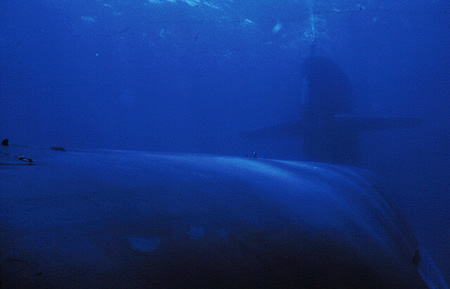 |
| Russian SSBN patrols tripled from 2007 to 2008. |
.
By Hans M. Kristensen
Russia sent more nuclear-armed ballistic missile submarines on patrol in 2008 than in any other year since 1998, according to information obtained by Federation of American Scientists from U.S. naval intelligence.
The information shows that Russian missile submarine conducted ten patrols in 2008, compared with three in 2007 and five in 2006. In 2002, no patrols were conducted at all.
Return of Continuous Russian SSBN Patrols?
For the past ten years, Russian remaining 11 SSBNs have not maintained continuous patrols, but instead carried out occasional patrols for training purposes. Defense Minister Sergei Ivanov said in on September 11, 2006, that five SSBNs were on patrol at that time. But since that number matched the total number of patrols conducted that year, it revealed a cluster of patrols rather than a continuous at-sea presence.
The United States, France and Britain, in contrast, continuously have at least one SSBN on patrol. In the case of the United States, two-thirds of its 14 SSBNs are at sea at any given time, of which four are on alert.
.
The ten Russian patrols in 2008 raise the question whether Russia has now resumed continuous SSBN patrols. Neither the duration nor the dates of Russian SSBN patrols are known, but if they east last more than 36 days and do not overlap, then Russia could have a continuous at-sea deterrent. If the patrols cluster like in 2006, then the posture might still be sporadic.
The Voyage of Ryazan
Although not specified in the information obtained from U.S. naval intelligence, one of the Russian patrols probably was the 30-days under-ice voyage of the Delta III-class submarine Ryazan from the Northern Fleet on the Kola Peninsula in the Barents Sea to the Pacific Fleet on the Kamchatka Peninsula in the Pacific.
|
Figure 2: |
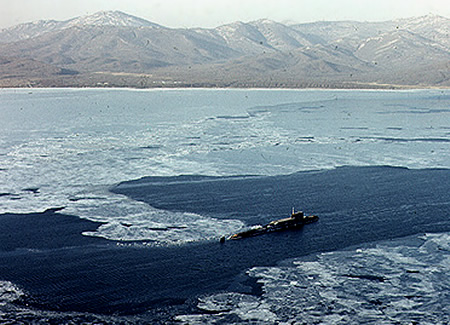 |
| One of the 10 SSBN patrols probably involved the transfer of a Delta III SSBN from the Northern Fleet to the Pacific Fleet. |
.
The voyage occurred shortly after Ryazan completed a successful test launch of a ballistic missile – probably an SS-N-18 – from the Barents Sea on August 1, 2008. The missile type was not announced, which is unusual, but its payload flew across Northern Russia and impacted in the Kura test range on the Kamchatka Peninsula.
At end the of August, Ryazan departed the Northern Fleet and sailed submerged along Russia’s ice covered northern coast through the Bering Strait before it headed south to the ballistic missile submarine base in Vladivostok, where it arrived on September 30.
Arms Control Implications
It would be ironic – now that the Obama administration has proposed reductions in strategic nuclear forces and Kremlin seems to respond favorably – if Russian SSBNs returned to the Cold War practice of continuous deterrent patrols.
SSBNs continuously roaming the oceans are one of the last symbols of the Cold War when long-range nuclear missiles were hidden in the deep to survive a massive first strike. United States SSBNs continue a patrol rate comparable to that of the 1980s, France and Britain try to keep one or two at sea at any time – two apparently collided last month, and China and India are trying to build SSBNs fleets too.
Many still see SSBNs as purely retaliatory weapons passively hiding in the oceans. But as U.S. and Russian nuclear forces are reduced further and China and India join the SSBS club, forward deployed submerged nuclear weapons could become some of the most problematic challenges for nuclear arms control.
United States Reaches Moscow Treaty Warhead Limit Early
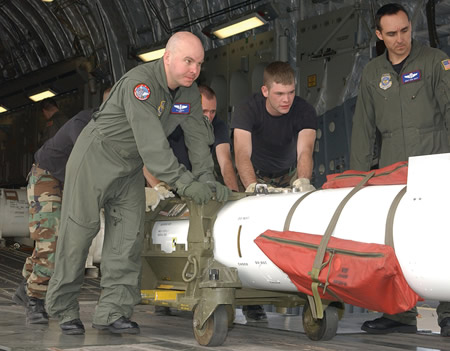 |
| B83 thermonuclear bombs are offloaded from a C-17 aircraft for storage in preparation for meeting the limit of the Moscow Treaty three and a half years early. |
.
By Hans M. Kristensen
The United States has reduced its deployed strategic warheads to the maximum number allowed under 2002 Moscow Treaty, three and a half years early.
As of today, a total of 2,200 strategic warheads are deployed on ballistic missiles and at long-range bomber bases. The reduction was initially planned to be met in 2012, then 2010, but was achieved a few days ago.
The information is described in the forthcoming “Nuclear Notebook: U.S. Nuclear Forces, 2009,” which I co-author with Robert Norris from Natural Resources Defense Council. The article will be published in the Bulletin of the Atomic Scientists later this month.
Warhead Number Confusion
We obtained the information from the U.S. government. While the number of operationally deployed strategic warheads is not classified the total number of weapons in the U.S. inventory is a closely held secret. The government also keeps secret how many warheads are held in reserve as well as the number of warheads dismantled each year.
As a result, there is considerable confusion in the public about the size and categories of U.S. nuclear weapons. One recent Associated Press report, for example, said the “American stockpile is believed to be about 2,300,” a number that is now being repeated by news media across the globe.
The stockpile number is not correct. Norris and I estimate that the U.S. “stockpile” currently includes approximately 5,200 warheads, of which only about half are deployed. This includes about 2,200 strategic and 500 tactical warheads (including 200 in Europe). Moreover, an additional roughly 4,200 intact warheads are no longer in the DOD Stockpile but awaiting dismantlement. All included, the United States is estimated to possess approximately 9,400 warheads in all categories (see table).
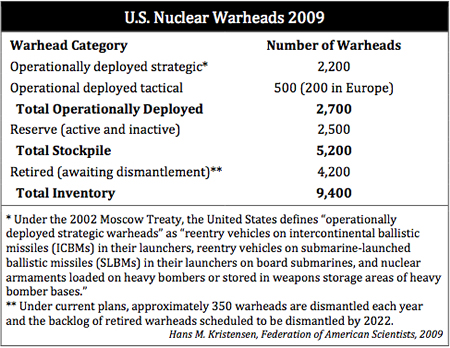 |
.T
The “operationally deployed strategic warheads” is a special counting rule the United States uses under the Moscow Treaty. It does not count hundreds of warheads in storage at the Navy’s two missile submarine bases and the Air Forces’ three ballistic missile bases. Russia, which does not use this counting rule and does not release its warhead count, is estimated to have approximately 2,700 operational strategic warheads.
Reductions But What Kind?
The “real” numbers are important at a time when the United States and Russia are discussing if and how to extend the 1991 START agreement, which expires later this year, and whether to reduce further the number of nuclear warheads.
The news media has recently reported that the Obama administration might seek to cut the “stockpile” by 80 percent, and quoted an anonymous official saying “nobody would be surprised if the number reduced to the 1,000 mark for the post-Start treaty.”
It matters a great deal whether the cut will be of the total stockpile or just the “operationally deployed strategic warheads.” An 80 percent cut in the 5,200-warhead stockpile corresponds to approximately 1,000 warheads. A reduction of the START number limit (6,000 warheads) by 80 percent would leave about 1,200 warheads. Cutting the SORT limit (2,200 warheads) to 1,000 would be a reduction of about 54 percent.
If the total stockpile were reduced to 1,000 warheads, only a portion of them would presumably be deployed. Using the current ratio (52 percent) that would mean only 520 of the 1,000 warheads would be deployed with the balance in reserve. The entire ICBM force today carries about 520 warheads, but it is doubtful that a Triad could be justified with so few operational warheads. There are some hard choices ahead about which leg to cut.
Chinese Submarine Patrols Doubled in 2008
 |
| Chinese submarines conducted 12 patrols in 2008, the highest ever. |
.
By Hans M. Kristensen
Chinese attack submarines sailed on more patrols in 2008 than ever before, according to information obtained by Federation of American Scientists from U.S. naval intelligence.
The information, which was declassified by U.S. naval intelligence in response to a Freedom of Information Act request from the Federation of American Scientists, shows that China’s fleet of more than 50 attack submarines conducted 12 patrols in 2008, twice the number of patrols conducted in 2007.
China’s strategic ballistic missile submarines have never conducted a deterrent patrol.
Highest Patrol Rate Ever
The 12 patrols conducted in 2008 constitute the highest patrol rater ever for the Chinese submarine fleet. They follow six patrols conducted in 2007, two in 2006, and zero in 2005. China has four times refrained from conducting submarine patrols since 1981, and the previous peaks were six patrols conducted in 2000 and 2007 (see Figure 1).
|
Figure 1: |
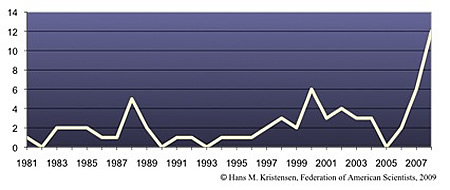 |
| Chinese attack submarines conducted 12 patrols in 2008, double the number from 2007. Yet Chinese ballistic missile submarines have yet to conduct a deterrent patrol. |
.
While the increase is submarine patrols is important, it has to be seen in comparison with the size of the Chinese submarine fleet. With approximately 54 submarines, the patrol rate means that each submarine on average goes on patrol once every four and a half years. In reality, the patrols might have been carried out by only a small portion of the fleet, perhaps the most modern and capable types. A new class of nuclear-powered Shang-class (Type-093) attack submarines is replacing the aging Han-class (Type-091).
Few of the details for assessing the implications of the increased patrol rate are known, nor is it known precisely what constitutes a patrol in order for U.S. naval intelligence to count it. A request for the definition has been denied. It is assumed that a patrol in this case involves an extended voyage far enough from the submarine’s base to be different from a brief training exercise.
In comparison with other major navies, twelve patrols are not much. The patrol rate of the U.S. attack submarine fleet, which is focused on long-range patrols and probably operate regularly near the Chinese coast, is much higher with each submarine conducting at least one extended patrol per year. But the Chinese patrol rate is higher than that of the Russian navy, which in 2008 conducted only seven attack submarine patrols, the same as in 2007.
Still no SSBN Patrols
The declassified information also shows that China has yet to send one of its strategic submarines on patrol. The old Xia, China’s first SSBN, completed a multi-year overhaul in late-2007 but did not sail on patrol in 2008.
 |
| Neither the Xia-class (Type-092) ballistic missile submarine (image) nor the new Jin-class (Type-094) have ever conducted a deterrent patrol. |
.
The first of China’s new Jin-class (Type-094) SSBN was spotted in February 2008 at the relatively new base on Hainan Island, where a new submarine demagnetization facility has been constructed. But the submarine did not conduct a patrol the remainder of the year. A JL-2 missile was test launched Bohai Bay in May 2008, but it is yet unclear from what platform.
Two or three more Jin-class subs are under construction at the Huludao (Bohai) Shipyard, and the Pentagon projects that up to five might be built. How these submarines will be operated as a “counter-attack” deterrent remains to be seen, but they will be starting from scratch.
China Defense White Paper Describes Nuclear Escalation
 |
.
By Hans M. Kristensen
A Chinese government defense white paper for the first time describes how China’s nuclear forces would gradually be brought to increased levels of alert during a crisis to deter an adversary and retaliate to nuclear attack.
The paper describes a growing portfolio of deterrence and counterattack capabilities with an ambitious agenda to control war situations with a more flexible deterrent and strategy.
Despite shortcomings, the paper provides a new level of Chinese transparency about its forces and planning.
Nuclear Escalation Phases
The white paper describes how the Second Artillery Corps (or Force, the term used by the paper) would change the operational status of the nuclear forces at different levels of crisis and conflict. Three levels of escalation are described:
Peacetime: Under normal circumstances – “in peacetime” – China’s nuclear missiles are “not aimed at any country.” The term “not aimed at any country” seems borrowed from U.S. terminology where it refers to the absence of targeting data in a missile’s guidance system rather than the alert level of the weapon. It has been assumed for many years that Chinese warheads were not mated with liquid-fuel missiles under normal circumstances (The situation with solid-fuel missiles has been less clear but might be similar).
|
Figure 1: |
 |
|
A warhead section is mated with a DF-3 liquid-fuel ballistic missile. Chinese nuclear warheads are thought to be stored separate from the missiles in peacetime. Image: web |
Nuclear crisis: If China comes under a nuclear threat, the nuclear missile force of the Second Artillery Corps “will go into a state of alert, and get ready for a nuclear counterattack to deter the enemy from using nuclear weapons against China.” In this phase, depending on the situation, mobile missiles would probably be dispersed to their deployments areas and presumably be aimed at the particular threat. If nuclear warheads were not already mated, they would be so too.
Nuclear attack: If China is attacked with nuclear weapons, the nuclear missile force of the Second Artillery Corps “will use nuclear missiles to launch a resolute counterattack against the enemy either independently or together with the nuclear forces of other services.” The “nuclear forces of other services” probably refers to the navy’s SSBNs and the Air Force’s bombers (see below).
Nuclear Missile Submarines
The submarine force is said to be equipped with “nuclear-powered strategic missile submarines,” a vague reference to the small fleet of perhaps 3-4 Jin-class SSBNs under construction.
The first was spotted at Xiaopingdao Submarine Base in 2007 and Hainan Island in 2008, the old Xia ended a multi-year overhaul at Jianggezhuang Submarine Base in 2008, although its operational condition is unknown.
The mission of the SSBNs is said to be “strategic deterrence and strategic counterattack,” which probably means non-alert operations in peacetime, increased readiness in a crisis, and the ability to counterattack in wartime. The paper states that the ability to counterattack is being improved, probably a reference to the new JL-2 SLBM on the Jin-class.
The mission description is vague and inconsistent. Whereas the section describing the navy’s development history uses the term “strategic deterrence and strategic counterattack,” the general force building section states that, “the submarine force possesses underwater anti-ship, anti-submarine and mine-laying capabilities, as well as some nuclear counterattack capabilities.”
Why the authors have used “strategic deterrence” in one part but only “nuclear counterattack capabilities” in the second part is unclear. Whether it is a vague reference to a nuclear cruise missile capability being added to some attack submarines is unknown, but absent any additional information might just be a matter of language.
A New Air Force Capability?
The Air Force section is interesting because it describes a “transition from territorial air defense to both offensive and defensive operations.” While much of this has to do with the introduction of new and more capable fighter and bomber aircraft and new concepts of operations, the white paper also describes “certain capabilities to execute long-range precision strikes and strategic projection operations.”
The force building section adds that in addition to traditional air force missions such as strikes and air defense, the transition involves increasing the capabilities for “strategic projection, in an effort to build itself into a modernized strategic air force.”
A small portion of China’s H-6 bombers have for decades been thought to have a secondary nuclear mission with gravity bombs, but the language in the white paper appears to go beyond that and might refer to some of the H-6 bombers being upgraded to carry a new long-range cruise missile intended for land-attack missions.
Most new cruise missiles will carry conventional explosives, but at least one – possibly the DH-10 – might also have a nuclear capability. The operational status of a nuclear cruise missile is highly uncertain and may initially be ground-launched, yet the U.S. Defense Department’s 2008 projection for Chinese nuclear forces vaguely referred to “new air- and ground-launched cruise missiles that could perform nuclear missions” and therefore “improve the survivability, flexibility, and effectiveness of China’s nuclear forces.”
Whether that means China is deploying nuclear cruise missiles remains to be seen.
Nuclear Weapons Capabilities
The paper describes that China over the past decades has built a weaponry and equipment system with both nuclear and conventional missiles, both solid-fueled and liquid-fueled missiles, with different ranges and “different types of warheads.”
The safety and surety features of those warheads and the personnel that handle them have been changed, the white paper states. For example, safety measures have been established to “avoid unauthorized and accidental launches,” measures that are needed for enhancing security but probably also for enhancing command and control of the weapons in the increasingly flexible scenarios the paper describes.
|
Figure 2: |
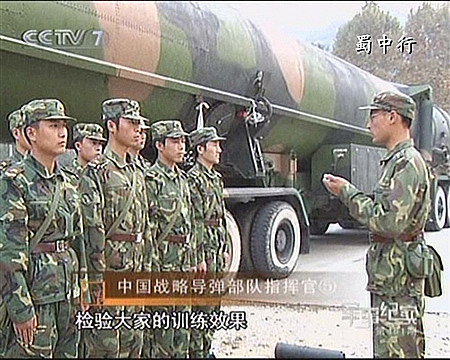 |
| Do Chinese solid-fuel DF-31 and DF-31A long-range ballistic missiles carry nuclear warheads in peacetime? In a crisis they most likely would under the escalation procedures described in the 2008 Defense White Paper. Image: CCTV7 |
.
Nuclear Weapons Policy
The white paper states that new military strategic guidelines have been issued that are aimed at “winning local wars in conditions of informationization.” The new guidelines stress “deterring crises and wars,” and “effectively control war situations,” and calls for “the building of a lean and effective deterrent force and the flexible use of different means of deterrence.”
Hovering above that evolution is a long-held policy of no-first-use of nuclear weapons, a self-defensive nuclear strategy, and a pledge never to enter into a nuclear arms race with any other country.
The good news about the no-first-use policy is that it is explicitly nuclear focused, and that China does not yet appear to have made it conditional on specific situations such as conventional attacks against China’s nuclear forces. This is important because some Chinese officials privately insist that a conventional attack against China’s nuclear forces would be considered a nuclear attack and the no-first-use policy therefore not a limiting factor in China’s response.
The not so good news is that the no-first-use policy in certain situations doesn’t seem credible. The pledge to “not be the first to use nuclear weapons at any time and in any circumstances” means that if an adversary invaded China and threatened the survival of the state, China’s nuclear forces would not be used as long as the invader did not use nuclear weapons. Hardly a credible policy.
Likewise, the pledge to “unconditionally not use or threaten to use nuclear weapons against non-nuclear-weapon states or in nuclear-weapon-free zones,” means that if the United States staged strikes against China from Japan or South Korea, Chinese nuclear weapons would not be used against U.S. bases in those countries. In that credible?
Despite these “credibility issues” in Chinese nuclear policy, the white paper is noteworthy because it indicates that China – unlike the other nuclear weapon states – has not yet fallen for the temptation to broaden its nuclear policy to deter all forms of weapons of mass destruction. The policy seems entirely focused on deterring and responding to nuclear attacks.
The white paper also states that China would like the nuclear weapon states to stop research into and development of new types of nuclear weapons, reduce the role of nuclear weapons in their national security policy, and reduce their nuclear arsenals. Those are good policy goals but they ring hollow given that China is busy deploying new nuclear weapons with new nuclear warheads and is the only of the five original nuclear weapon states that is thought to be increasing its nuclear arsenal.
As China increases its capabilities and pursues a more flexible deterrent posture, there is a risk that its policies will be modified too. With increased flexibility in capability tends to come increased flexibility in mission.
Oh, and in case you wondered: while the U.S. military plans against “red forces,” the Chinese plan against “blue forces.” Some things never change.


